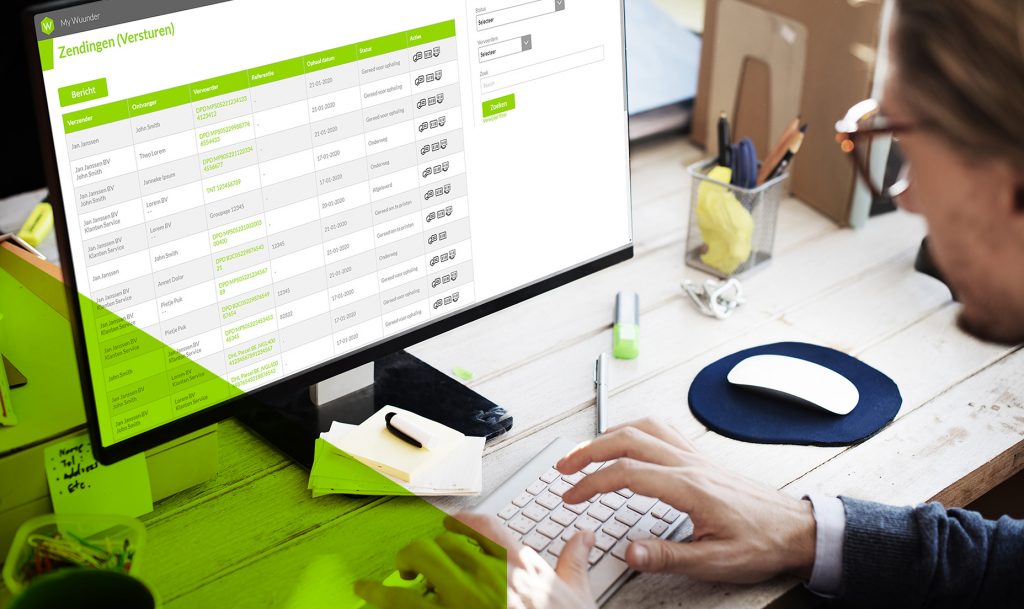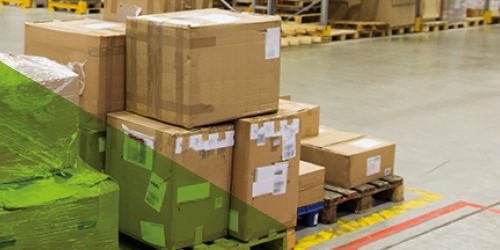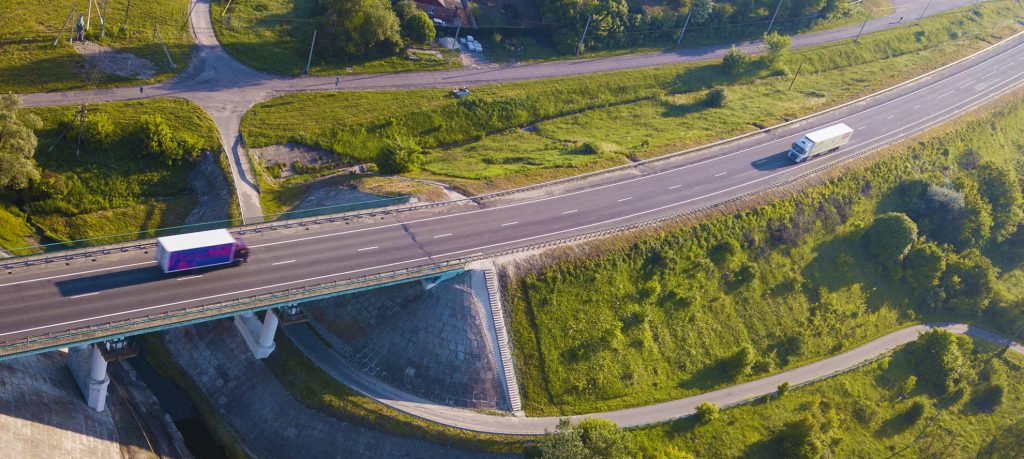Send pallets
Sometimes it is more economical to transport several packages on a pallet (wooden or plastic landing carrier) than to send each package separately with a parcel carrier. When sending some items that are too heavy to be sent as a package (often over 30 kg, because this can no longer be lifted from an occupational health and safety point of view), a pallet is the only option.
With pallets it is more important than with packages to take a number of things into account. A receiver that is not at home or a business receiver that is always closed on Mondays cause costly second deliveries or worse: returns. We summarize the points of attention for you:
The product
If you want to send a product to a country outside the European Union, you as a sender must familiarize yourself with the export requirements that apply to the country in question. Each country has its own conditions and other products to which they set requirements. The different rules are there to protect consumers, protect the environment or protect the home market against (unfair) competition. In addition, carriers may also impose restrictions on certain goods, such as lithium batteries, glassware, live animals, works of art and dangerous goods.
The package
Preventing damage is very important with pallets. Not only because shipments are loaded into and out of a truck several times with a forklift, but also to avoid extra costs. In general, however, you can say that pallet transport has less damage than the transport of packages, because the shipment is not sorted via a conveyor belt and if the shipment is high enough, nothing is stacked on your pallet. By taking the following points into account, you further reduce the chance that your pallet will be damaged:
- Product too large: the biggest cause of damage is the product crossing over on the pallet. Always make sure that your product fits within the maximum dimensions of the pallet. If you do not do this, your shipment will come into contact with the pallets that are placed against your pallet.
- Product is loose: secure your product to the pallet with straps. Not only do you ensure that the product cannot slide off the pallet, but also that your product cannot fall over while moving the shipment with a forklift. Edges not protected: use corner profiles on the side of your product to prevent other pallets (sometimes overhanging) from hitting your product. The sides are the most vulnerable, because other pallets are placed next to them.
- Not water resistant: assume that your product can get wet. Not only when loading and unloading the pallet, but also during transport in the truck. Wrap a stretch or shrink film around the product and the pallet (sealing). Make sure that the foil is also on top and continue to wrap over the wooden pallet. Note that the forklift must of course still be able to slide with the forks underneath.
- Not stackable: assume that another pallet or package can be placed on top of your pallet. If your pallet is not flat at the top, make sure it is protected with an extra empty box, cardboard plate or wooden board. If a pallet is not 'stackable', surcharges follow with most carriers. More on this later.
- Shareable content: when the shipment can be divided into individual packages, it is smart to put the heaviest packages on the pallet first. Try to distribute the weight so that a pallet is not top heavy and can fall over when lifted with a forklift or pallet truck. While driving, pallets are secured with lashing straps or lashing bars and here too an incorrectly loaded pallet can cause damage.
- Too high, wide or long: Depending on the carrier, there are limits to the dimensions of the pallet. If your pallet is transported by air, this requires a different maximum height (160 cm) than, for example, road transport (180-220 cm). Make sure you use standard dimensions. For road freight this is: Euro pallet 120 x 80 x 180, Block pallet 120 x 100 x 180 or mini pallet 60 x 80 x 180. A Euro pallet meets certain standards and can be recognized by the EUR brand on the side of the pallet.
- Too heavy: Moving a pallet naturally becomes more and more difficult as the weight increases. If you go over 1000 kg, a forklift is needed to remove the shipment from the truck and it must be possible to load and unload the truck from the side. So don't try to put everything on 1 pallet, but split it so that these standard pallets fit. Each country and carrier has different maximum weights.
- The pallet: make sure your pallet meets international standards (ISPM 15). For example, a pallet must be treated against vermin (fumigated). Only if you make agreements in advance with the carrier, you will receive the pallet back or you will receive a 'deposit' back. This is not the same pallet but a comparable pallet. The pallet must be suitable for reuse. There are also single-use pallets (disposable pallets) and of course plastic pallets. The latter are sometimes even prescribed to send certain types of goods, such as foodstuffs. Due to the rising wood prices, pallets are not cheap. Therefore, never throw away pallets and keep them so that you can reuse these second-hand items. Cheap and good for the environment!

Choose the transport service
There are several ways you can ship a pallet:
- Groupage: this is the most commonly used method, also known as ABC transport. Book today (day A), load tomorrow (day B) and deliver the day after tomorrow (day C). Please note that both collection and delivery are not guaranteed. This is based on availability. In short: if the carrier has a daily trip to a destination and the truck is full, the shipment remains until the next trip. Most groupage carriers collect the shipment locally, after which pallets for the same destination are bundled and driven to a destination via a truck (linehaul). Here the shipment is again transported locally to the recipient.
- Express: these are fast deliveries where the shipment is sometimes even picked up on the same day and delivered the next day. These are often carriers such as TNT/Fedex, DHL Express and UPS.
Of course, each carrier has its own specialty. There are several things that you should take into account when choosing the transport service:
- Network: there are very few carriers that can do just about anything. Most carriers have a regional or national focus or focus on a certain group of countries or even one specific country. For example an Eastern Europe specialist or a France specialist. Because shipments are collected locally, bundled per destination and then transported locally, communication between the carriers is very important. At each handover moment, the need for additional communication arises if something does not go well. In addition, noise is created faster because the carrier has to request information such as the location of the shipment from the partner.
- Speed of delivery: a shipment that has to be quickly to the other side of the world can best be sent with an Express network. The transit time of a shipment is important if the recipient wants the shipment quickly. There are various options such as a direct ride (Sameday), Nextday (Express) or Groupage.
- Dimensions and weights: each carrier has a preference for a certain size and weight of a pallet. Surcharges are often applied for pallets that are outside the ideal size of the carrier. Usually these surcharges have to do with the length, width, height or weight of the pallet. To avoid surcharges, it is smart to choose a carrier where the specifications of your shipment fall within the standard of this carrier.
If you do not use the standard pallet size, many carriers have a rate calculation based on loading meters. This is the floor space that the pallet takes up in the truck and is calculated as follows:
Multiply the length (in meters) of the pallet by the width (in meters) of the pallet and divide by 2,4 meters (the maximum width of a truck).
For example: the size of a Euro pallet is 1,2 m in length and 0,8 m in width. 1,2 x 0,8 / 2,4 = 0,4 loading meters. A block pallet is 0,5 loading meters.
Express carriers use the term current and volumetric weight. The current weight is the measured or weighed weight. This is the weight if you put the shipment on a scale. The volumetric weight is a bit more complex to calculate:
length of the package (cm) x width of the package (cm) x weight (kg) of the package ÷ volumetric divider.
This volumetric weight sharer often differs per carrier and service. For example, an 80 x 50 x 35 package with a volumetric weight divider of 5000 has a volumetric weight of 28 kg.
Usually the carrier uses the heaviest weight. So if the volumetric weight is 28 kg and the measured weight is 20 kg, the carrier will charge 28 kg. The volumetric weight is used by the carrier, because the transport of, for example, a kg of springs in an enormously large package is more expensive for the carrier than a XNUMX kg brick in a small package.
- Number of shipments to the same address: most carriers give a discount if you have multiple shipments delivered to the same recipient at the same time. You must book these shipments at the same time. Please note that many carriers such as DHL eCommerce NL take a maximum number of pallet shipments per day. Fortunately, Wuunder also has a solution for entire trucks or Full Truckload (FTL) and Less Than Truckload (LTL).
- Not stackable: Please specify when booking whether the pallet is stackable or not. When the pallet is stackable, you usually receive a discount. If a pallet is not stackable, you usually pay for the full height of the truck (180-220 cm). Prevent something from being put on your pallet by placing an empty box on the pallet. Also indicate with stickers that the pallet is 'NON STACKABLE'. Stick these stickers on all sides.
- Pick-up: the pick-up of a pallet is usually included in the cost. Pallet carriers usually pick up an occasional shipment on the next business day. Express carriers often arrive on the same day. The time until which you can pick up a shipment the same day varies per location. The further you are from a depot of the carrier, the sooner you have to register the shipment.
- Choices for the recipient: it is not common in the transport of pallets that the recipient has the possibility to influence the delivery date. It is common, however, that when booking the service, the sender chooses an extra service such as delivery before 12 noon or delivery with priority.
- Business or private recipients: there are carriers that do not deliver to private individuals such as DHL eCommerce in the Netherlands. Often extra costs are charged when delivering to a residential area. This is often caused by the fact that it is almost impossible to deliver with trucks and the delivery takes more time. The larger business recipients have access to a loading/unloading pit, which means that a truck with a tail lift is not required. If the recipient does not have this facility, it must be indicated when booking that a tail lift is required. This is not common for international transports. Usually carriers apply extra costs for this.
Please note that the delivery date is not guaranteed. If the recipient is not present, costs for a second delivery will be charged. Is the receiver closed on Mondays or not present at other times? When booking, make sure you choose a carrier that makes an appointment with the recipient. This is not common in pallet transport and results in a substantial surcharge. If the carrier has to keep the shipment until a suitable delivery time, it will charge storage costs for this.
- Green: there are few freight carriers that deliver CO2 neutrally. Only a few transporters compensate the emissions by planting trees or buying off the emissions. It is also quite unusual to use electric or LNG vehicles for the delivery of pallets.
- Return options: Picking up pallets abroad is often possible at business addresses. In exceptional cases, pick-up is also made from consumers at an additional cost.
We are happy to help you make the right choice. Click here for an overview of pallet carriers. Or ask here an offer.

Rates
The various components described in the previous section affect the rate that will be charged. Carriers therefore have additional surcharges:
- Ad hoc or regular: there is a big difference between a one-off pallet transport (ad hoc) that is purchased via spot rates (current rates) and a transport that will occur regularly. For example, 10 pallets per day to location X. If the transport is regular and therefore planable, a quote can be issued for a longer period of time. If you want to book an ad hoc transport in a peak period, you will of course pay more. This is also the case, for example, on the last Friday of the month, a day that is traditionally busier than other days.
- Additional services: freight forwarders use various extra services, such as delivery before 10 or 12 hours or with priority.
- Shareable content: if the shipment can be divided into individual packages, it is smart to always calculate whether individual packages are not cheaper than a pallet. Usually with more than eight packages to the same address within the Netherlands, it is smarter to send the shipment as a pallet. When calculating, of course, keep in mind that you will not always get the pallet back and the purchase value will therefore also be lost.
- Size: Pallet carriers also want to be able to stack as many pallets on top of each other as possible. If your pallet cannot be stacked because it has an odd shape such as a triangle, most carriers will charge a 'non-stackable' surcharge. If the pallet is larger or heavier than allowed, it will be returned and a substantial surcharge will follow.
- Incorrect dimensions and weights: Most carriers charge extra costs if the dimensions of your shipment are incorrect. If the carrier expects a Euro pallet, but it turns out to be a larger pallet, it can also happen that the pallet cannot be taken along because it does not fit in the truck. Freight carriers also charge extra for this (failed pick-up).
- Fuel Surcharge: with pallets, the impact of a fuel surcharge is even greater than with a package. Due to the rising fuel prices, a surcharge of 20 percent is currently common practice.
- Prepare customs forms and clearance costs: freight forwarders charge a substantial extra amount for checking the commercial invoice and customs form. Some carriers also charge this when the recipient refuses the shipment. If you forget to add the commercial invoice to the shipment, the shipment will often be returned or the carrier will ask you to send it (more about this later).
- Consumer delivery: deliveries in a house (residential area) are regarded as consumer delivery, even if, for example, a physiotherapy practice or hairdresser is located here. These business addresses often have to be delivered with small box trucks, which means that the costs are higher.
- Second delivery: A surcharge will be applied if the recipient is not present when the carrier attempts to deliver the shipment.
- Return: if a shipment cannot be delivered, you usually pay both the outward and return journey plus a fine.
- Remote areas: carriers charge extra if the shipment has to be delivered to a remote area. In the Netherlands, for example, these are the Wadden Islands. Freight carriers often do not have a rate per country, but a rate per postcode area. In areas where they have regular deliveries, you pay less and in areas that require extra driving without combinations with other deliveries, you pay more.
To ensure
When you send a product with a high value, it is important that you make a choice whether additional insurance is necessary
- Groupage carriers: de Most freight carriers charge a kilo price when a shipment is lost. Carriers use CMR conditions for transport within the Netherlands and AVC conditions for transport outside the Netherlands. The carrier is thus liable for loss and damage. However, standard liability is limited. For CMR this is about 10 euros and for AVC about 3,40 euros per kilogram.
- Express: because many cameras are used in these networks at every sorting center, the chance that a package gets lost is much smaller than with parcel post. Here again the CMR and AVC conditions apply and you can insure a shipment extra.
The role of the recipient is quite large in pallet transport insurance. If the recipient signs for receipt, it is usually no longer possible to claim damages. Inform the recipient about this and make sure that if there is damage this is stated on the consignment note that the recipient signs. Take a picture of this immediately and inform the carrier. This often prevents a claim from being rejected.
Extra insurance is usually possible against the 'declared value' or the value of the shipment. The options offered by these insurance policies are usually very extensive. You can of course also take out transport insurance yourself if you regularly send valuable shipments. This is often cheaper than taking out insurance through the carrier.
Wuunder's software can be set up in such a way that shipments above a certain value are immediately additionally insured.

The shipping label
The contents of a shipping label may seem like a simple choice, but nothing could be further from the truth… You have to pay attention to the full things here:
- Correct address: It is of course very self-evident that a correct address is necessary for a delivery to be successful. Therefore, try to validate the address in the check-out. Often a house number is forgotten in a hurry. Provide the option to add an addition to the location in a second address line, such as 'building A, apartment 2'. Sometimes even GPS locations are used here to make it easier for the delivery person. In some countries there are still no postal codes such as in Hong Kong and the Netherlands Antilles. Please note that sending to a PO box or freepost number is often only possible via a postal carrier (letter post) such as PostNL or Bpost. If you send via another carrier to a PO box or freepost number, the shipment will be returned.
- Phone: the telephone number is often used by drivers abroad to contact the recipient. If the recipient does not answer, the driver often does not take the risk of driving to a remote home and the shipment is delivered to a parcel shop.
- E-mail: the e-mail address is used by the carrier to inform the recipient of the arrival of the shipment. If you do not use the e-mail address, the chance of a return is greater, because the recipient does not know when to expect the shipment. You also do not give the recipient the opportunity to influence the delivery. For destinations outside the EU such as Switzerland and Norway, the e-mail address is used to pay the import duties.
- Reference: when a shipment has a high value, it is important not to use the contents. So don't use as reference for example: Apple iPhone 13.
- Stickers: Most freight carriers don't have shipping labels like they do with parcels. However, Wuunder always generates a shipping label. Stick the shipping label at eye level in the center of the short side of the pallet. This is the side where the forklift picks up the shipment. Sticking a label on both sides makes it easier for the forklift driver. Express carriers all have their own labels. Also make sure that the ink does not run out during the printing of the shipping label. There are special printers on the market for printing shipping labels. When a barcode cannot be scanned by the carrier, surcharges often follow.
- Shareable content: if the shipment can be divided into individual packages, it is smart to always stick extra stickers on several sides of the pallet with the text 'DO NOT BREAK DOWN'. This is especially recommended if you send the pallet with a pallet carrier such as DHL Parcel, TNT, FedEx or UPS. If you do not do this, pallet shipments are sometimes sent as individual packages. When the individual packages are not provided with shipping labels, this usually results in the loss of part of the contents of the pallet.
The commercial invoice
If you send a shipment to a country outside the EU such as Norway, Switzerland and England, you must also stick three commercial invoices on the shipment in addition to the shipping label. Read more about this on our website. Wuunder employs various specialists who know everything about import and export.
Import duties
Within the EU you can send goods freely and you have to charge VAT. You can of course get these costs back from the tax authorities.
If you send a shipment to a country outside the EU, the recipient does not pay VAT on the value of the purchase, but pays these import duties. The amount of this amount depends on the nature of the product and the country of receipt. For business customers, the carrier is often asked to state the VAT numbers immediately, so that settlement is more efficient. For private individuals, the carrier sends an e-mail with a request for payment. If the recipient does not comply with the import duties, the shipment will be returned. This must therefore be communicated well with the buyer.
Tracking the shipment
When sending a pallet, it is not usual that you can continuously follow the shipments via a track & trace system. On the one hand because these shipments are removed from trucks as little as possible and scanning is therefore not possible, but also because most pallet transporters are less automated. You will always receive a Proof Of Delivery (POD) or proof of delivery or signature for receipt.
With Wuunder you don't have to worry about this: we proactively track the shipments of our customers. We keep a close eye on everything from collection to delivery. If something goes wrong during the shipping process, such as delays or an incorrectly entered address by the recipient, we will contact the carrier immediately to resolve this. We call this service the control tower.
Communication with the recipient
Good communication is crucial for the recipient of the package. By proactively communicating with the recipient about the status of the order, you avoid unnecessary phone calls, emails and frustration. Wuunder takes this communication off your hands. We inform the recipient about the delivery process and when something goes wrong we keep them informed in detail. As a result, the recipient always knows what is wrong with the shipment and a successful delivery can be trusted.






